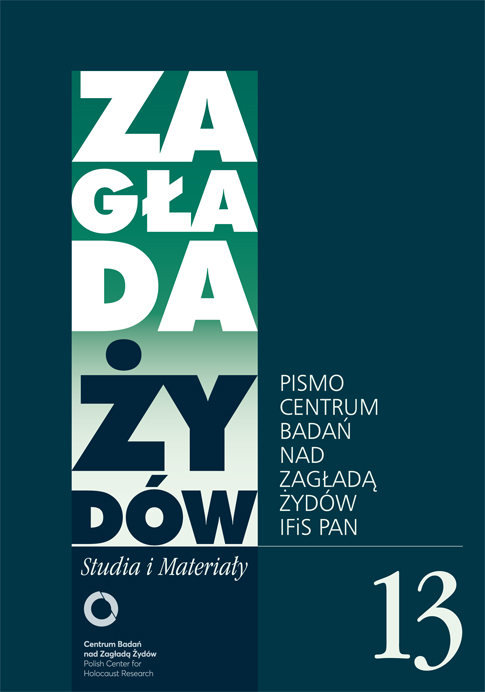Bernard Mark, powstanie w getcie warszawskim i proces Jürgena Stroopa
Zagłada Żydów. Studia i Materiały, Nr 13 (2017), Strony: 181-202
Data zgłoszenia: 2020-10-17Data publikacji: 2017-12-03
 https://doi.org/10.32927/ZZSiM.356
https://doi.org/10.32927/ZZSiM.356
Abstrakt
Jürgen Stroop, the SS general who led the liquidation of the Warsaw Ghetto and the suppression of the Warsaw Ghetto Uprising in April–May 1943, was convicted by a Polish court in 1951 and executed in 1952. Bernard (Ber) Mark (1908–1966), Holocaust historian and director of the Jewish Historical Institute in Warsaw, provided expert testimony for the prosecution at Stroop’s trial. Mark felt constrained to graft a communist-inflected narrative onto his account of the Warsaw Ghetto Uprising and to shoehorn it into his expert testimony in court and then into his interpretation of the trial for a Jewish audience. He did his best to give the Jewish Fighting Organization, which spearheaded the uprising, and its Jewish fighters their due at a time when expression of unvarnished appreciation for Jewish heroism was risky, even while he was paying overrated tribute to the communist underground for its assistance to the Jewish rebels during the uprising. But he always stopped short of the line between conformity to and defiance of the communist regime
Słowa kluczowe
Bernard Mark , Żydowski Instytut Historyczny , powstanie w getcie warszawskim , proces Jürgena Stroopa
Licencja
Prawa autorskie (c) 2017 Autor & "Zagłada Żydów. Studia i Materiały"

Utwór dostępny jest na licencji Creative Commons Uznanie autorstwa 4.0 Międzynarodowe.
https://creativecommons.org/licenses/by/4.0
Inne teksty tego samego autora
- Gabriel Finder, Proces Szepsla Rotholca a polityka kary w następstwie Zagłady , Zagłada Żydów. Studia i Materiały: Nr 2 (2006)
- Gabriel Finder, Svenja Bethke, Dance on the Razor’s Edge:Crime and Punishment in the Nazi Ghettos [Gabriel N. Finder] , Zagłada Żydów. Studia i Materiały: Nr 17 (2021)
Podobne artykuły
- Dariusz Libionka, The Fighting and the Propaganda: The Uprising in the Warsaw Ghetto from the Perspective of ‘Polish London’ , Zagłada Żydów. Studia i Materiały: Nr Holocaust Studies and Materials (2017)
- Barbara Engelking, M. Maur Getto płonie , Zagłada Żydów. Studia i Materiały: Nr 19 (2023)
- Jacek Leociak, „Za wyżej wymienione pamiętniki nie żądałem żadnej zapłaty”. Jak Władysław Wójcik ratował dziennik Chaima Arona Kapłana i Archiwum Ringelbluma , Zagłada Żydów. Studia i Materiały: Nr 13 (2017)
- Havi Dreifuss, „Oni wciąż we mnie żyją”. Israel Gutman (1923–2013): ocalały z Zagłady, uczestnik powstania w getcie warszawskim, historyk żydowski , Zagłada Żydów. Studia i Materiały: Nr 10 (2014)
- Aleksandra Bańkowska, Między odpowiedzialnością a bezsilnością, ofiarnością a pokusą. Pracownicy opieki społecznej w getcie warszawskim wobec podopiecznych i petentów , Zagłada Żydów. Studia i Materiały: Nr 20 (2024)
- Agnieszka Witkowska-Krych, Główny Dom Schronienia , Zagłada Żydów. Studia i Materiały: Nr 13 (2017)
- Maria Sławek, Muzyka jako forma upamiętnienia powstania w getcie warszawskim , Zagłada Żydów. Studia i Materiały: Nr 19 (2023)
- Yisrael Gutman, Christopher R. Browning, Raporty żydowskiego „informatora” z warszawskiego getta [oprac.Christopher R. Browning i Izrael Gutman] , Zagłada Żydów. Studia i Materiały: Nr 2 (2006)
- Krystyna Radziszewska, Wydział dla Wsiedlonych w getcie łódzkim w świetle dokumentów archiwalnych i tekstów autobiograficznych , Zagłada Żydów. Studia i Materiały: Nr 16 (2020)
- Adriana Bryk, „Najlepsze dziecko Prezesa” – poczta w getcie łódzkim (1939–1944) , Zagłada Żydów. Studia i Materiały: Nr 16 (2020)
<< < 1 2 3 4 5 6 7 8 9 10 11 12 13 14 15 16 17 18 19 20 21 22 23 24 25 26 27 28 29 30 31 32 33 34 35 36 37 38 39 40 41 42 43 44 45 46 47 48 > >>
Możesz również Rozpocznij zaawansowane wyszukiwanie podobieństw dla tego artykułu.
 English
English
 Język Polski
Język Polski



 https://orcid.org/0000-0003-2829-3979
https://orcid.org/0000-0003-2829-3979





